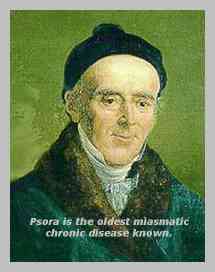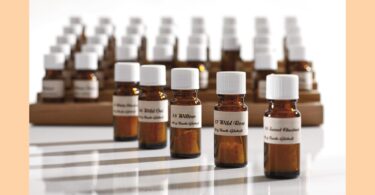Introduction to miasms
“The absolute of the disease is the miasmatic impact.” [1]
Searching for the true cause of diseases behind symptoms Hahnemann discovered that the chronic miasms constitute the distortive energy which derange the vital force. Hahnemann defined miasms as “infectious principles” and associated each miasm with specific diseases. He distinguished between acute, half-acute and chronic miasms. They arise from contagion, creating a miasmatic state, or diathesis, and forming a predisposition to a characteristic form of disease. True chronic miasms modify the course of acute diseases and establish a permanent field for chronic diseases. The vital force is unable to eradicate chronic miasms, nor even not the most robust constitution, healthiest life-style or best diet.
“One has always to deal with a segregated part of a deeper lying original evil, the large extent of which is shown by new symptoms from time to time…. But the original evil sought must also be of a miasmatically chronic nature – as was perfectly evident to me from the fact that, once it had developed to a certain degree of intensity, it could not be eradicated by the mere vigor of a robust constitution. Neither could it be overcome by the healthiest diet and order of life, nor annulled by itself, but in the course of years it grew worse with the addition of other more serious symptoms – right up to the end of life.” [2]
When the vital force is unbalanced the miasms display their negative, maladaptive effects, creating symptoms and diseases. Everyone has a combination of all miasms, but the miasmatic make-up differs in each subject in quantity and degree. Usually, one miasm predominates, but the predominant symptoms may also correspond to more than one miasm. Each miasm has its own distinctive characteristics and disease propensities. Based on the chronic miasms the patient passes through states of illnesses with a characteristic connecting link. However, despite the collective picture of the chronic miasms, each patient displays their own individual symptom pattern.

Miasms become activated and increase in their intensity by certain stressful events the subject is susceptible to. They affect the whole person and cause mental, emotional and/or physical symptoms. “How much a miasm becomes visible depends on their stage and intensity in the organism.” [3]
Sleep and sleep disturbances
Sleep is a naturally recurring state characterized by altered consciousness, relatively inhibited sensory activity, and inhibition of nearly all voluntary muscles. It is distinguished from wakefulness by a decreased ability to react to stimuli. During sleep, most systems in humans are in a heightened anabolic state, accentuating the growth and rejuvenation of the immune, nervous, skeletal, and muscular systems. Sleep in non-human animals is observed in mammals, birds, reptiles, amphibians, and fish, and in some form in insects and even in simpler animals such as nematodes, suggesting that sleep is universal in the animal kingdom. [4]
We spend a third of our lives sleeping. Each of us has problems sleeping at times. We might have nights when we find it difficult
Sleep in homeopathy
Symptoms are the language of a disease and mirror the miasmatic state of the subject. In homeopathy signs and symptoms are defined as the outward manifestation of the internally deranged vital force – which is the primary cause of all diseases. Signs and symptoms might be noticed by the patient himself, or observed by others, his relatives or the physician, and aided by other means of investigations.
Sleep is not to be seen as an isolated symptom as it is always the whole person who is sick. The sleep pattern itself, the sleep position, as well as the mental, emotional and physical symptoms that occur before, during or after sleep constitute important general or particular symptoms, which, together with other individual symptoms help to form the totality of the patient’s characteristic symptom picture. If allowing individualization by being strange, rare or peculiar then they assume the highest rank in the hierarchy of symptoms and are of special value for finding the indicated remedy as outlined in §153 Organon.
Dreams are of special value as they directly arise from the unconscious. The unconscious is where most of the work of the mind gets done, long before we may become aware of them. Unconscious processes in the mind occur automatically and are not available to introspection, or suppression. As such dreams can express important feelings and unresolved conflicts the patient is unaware of.
Sleep and dream symptoms help us in finding the indicated remedy as well as to judge the prescription and whether treatment moves into the right direction – balancing the vital force and lessening the patient’s miasmatic burden, disease and symptoms, including the normalization of sleep patterns and related symptoms.
Miasms and their related sleep symptoms
As each miasm is related to a distinctive set of characteristic symptoms the patient’s sleep will display the currently active miasm.
The Psoric miasm and sleep
Keynotes: the sensitizing miasm (L), irritation, inflammation (D), deficiency, lack
Central idea: lack of strength and need for support (L)
Sleep:
Unrefreshing. (B)
Unrelaxed in the morning.
Weariness on waking. (B)
Somnabulism. (B)
Sleepineness during the day, (B) often immediately after sitting down, especially after meals.(H)
After 3 a.m. no sleep, or at least no sound sleep.(H)
Difficulty in falling asleep, when in bed in the evening, often lies awake for hours.(H)
Psoric sleeplessness is caused by an abundance of ideas(B)
Psoric patients wake up at night worrying about everything. This anxiety mainly tortures them at night, robbing them of their sleep, since they keep themselves busy during the day. Alone at night, they have time to reflect.(L) Itching and burning, together with their restlessness and chronic worries, lead to insomnia and a loss of energy.(L)
Fear of darkness.
Thinking about problems and making a “to do” list at night.
Very good sleep, children fall asleep easily and feel refreshed on waking. (J) Awakes more tired then when going to bed. Sleeplessness due to intolerable itching. (D)
Sleep disorder, cannot relax. Restless, cannot find a comfortable position. Sleeplessness from over excitement, severe skin itching. Itching on the after from worms or in stressful situations prevents sleep.(J)
Sleepy after eating, sleepy during the day.(J)
Doesn’t feel refreshed after sleep, needs coffee or tea to feel awake.(J)
Wakes up from dreams.
Difficulty falling asleep, wakes up at 3a.m., difficulty falling asleep again.
Psoric sleeplessness is caused by intense itching or difficulties to relax. Psoric patients need a long time to find a comfortable position and are restless.
Children have difficulties falling asleep because they fear to miss something. Especially when being visited by someone they need a lot of time to fall asleep.
Awakes frightened.
Difficulty falling asleep, in the evening when lying.
Cannot sleep for several hours.
Just drowsy.
Dreams:
Fearful, anxious and frightful dreams. (B)
Fearful images and distorted faces appear as soon as the patient closes their eyes. (B)
Vivid dreams as if the patient were awake. (B)
Sad, lascivious dreams. (B)
Dreams of daily activities such as cooking, fishing, flowers, home and house, music etc; from undertaken efforts, no matter whether successful or not such as climbing a high, striving, climbing a step, failures, looking for someone and not finding him, trying to reach something.(V)
Emotional dreams with emotional causes such as grief, anger etc.(V)
Each type of anxious dream. Pleasant dreams such as beautiful landscapes, driving a car, flying in the airplane, new places, pleasant, rainbows spanning over the sky, swinging.(V)
Psoric dreams center around anticipation anxiety accompanied by a hyperactive psyche. In dreams, ideas or unfulfilled desires may be expressed wavelike. Psoric dreams display sadness, love, jealousy, anxiety or fright. (P)
Dreams of urinating, passing stool and other dirty discharges. (D)
Nightmares, dreams of physical exertion.(J)
Modalities:
Psoric symptoms get worse during sleep. (B)
Worse from lack of sleep.(J)
Concomitants:
Perspiration during sleep, especially on the head. (B)
Snoring, salivation, grinding or gnashing of teeth during sleep. (B)
Twitching of muscles during sleep. (B)
Loud talking and screaming during sleep. (B)
Passing of stool and urine, or expulsion of round worms during sleep (B)
Attacks of suffocation while sleeping.(H)
Anxious oppression, early on awakening.
After a very restless night, he often has more strength in the morning, than after a quiet, sound sleep.(H)
Melancholy, violent beating of the heart, anxiety, and extreme nervousness often awakens the psoric patient from sleep.(S)
Always tired, tired during the night, even after sleeping; becoming better during the course of the day, as soon as sun rises and increases their strength.(A)
Burning in foot soles, numbness of extremities, and the sensation as if parts were falling asleep are worse when lying or after sleep. (A)
Grinding of the teeth at night.(D)
Hungry at night, enuresis nocturna, snoring, talking, laughing, weeping, singing grinding teeth, twitching muscles during sleep.(J)
Hot feet in bed.
Chewing and swallowing during sleep.
Perspiration in the morning in bed.
The Sycotic miasm and sleep
Keynotes: excess and overgrowth (L), induration, infiltration (D), uncoordination, proliferation
Central idea: over-stimulation and excessive growth (L)
Sleep:
Restless sleep. (B)
Persistent insomnia.(F)
Sleeplessness due to mental and physical disquiet. (B)
Sleeps for a short time, wakes, then returns to sleep again. (B)
The sycotic patient works throughout the night and sleeps until late in the day They are too excited to sleep at night, even preferring mental work to sleep. Sycotic teenagers will stay up until well past midnight on school nights, then they are exhausted when they have to get up early the next day. L)
The sycotic baby is “good” only when asleep. He frets and moans and cries all day and is quiet at night. (L)
May sleep on his hands and knees, with face buried in the pillow.(L)
Sleepless while lying on the left side.(F)
Excessive anxiety disturbs sleep.(A)
Sleep position: on stomach, cannot sleep when lying on the left side.(J)
Suddenly awakes with the feeling of having slept too long.(J)
Dreams:
Sexual dreams with fantasies. (B)
Dreams of construction, gatherings, accumulation such as great gatherings, taking part at a ball, birth of a child, computer, gathering fruits, gardens, swollen body parts etc.(V)
Dreams of business with money such as being busy, calculating, associations, discussions, money, growing large etc..(V)
Terrible, emotional dreams such as danger, death, disgrace, humiliation, suppressed emotions, jealousy, profession, political, deceitful etc. (V)
Dreams which involve hiding something such as masks, hiding etc (V)
Sycotic dreams go along with a certain over sensitiveness. There might be conflicts caused by a negative environment. A tiredness might also be shown which leads to a slow down and inertia. with a bad memory. (P)
Sycotic patients have difficulty remembering their dreams or can only explain them insufficiently, which can change to a paranoid state of mind or a hypochondriac constitution. (P)
Dreams of failure, a lack of confidence and uncertainty as well as dreams about death also belong to the sycotic miasm. (P)
Dreams of falling down, ghosts, battles, of being chasen, or of pain. (D)
Dreams of falling from a height, that someone is choking him.(J)
Modalities:
Restless sleep in damp, humid weather and during thunderstorm. (B)
Sleep better on the seaside.(J)
Sleep disturbances caused by disturbed digestion – colic, fullness.(J)
Concomitants:
Sycotic’s mental energy becomes much better at night, reflecting the daytime aggravation of sycosis, the amelioration time is from 8p.m. to 3 a.m.(L)
Moaning during sleep.(F)
Perspiration during sleep, ameliorated on and after waking.(F)
Lively in the evening and night, tired and hangover in the morning.(D)
The Syphilitic miasm and sleep
Keynotes: the destructive miasm (L), degeneration, ulceration (D)
Central idea: destruction on all levels (L)
Sleep:
Sleepless due to tormenting ideas. (B)
Sleeplessness because of depression, restlessness, negative thoughts (hates life, everything, everybody), suicidal thoughts.
Sleepless since birth.
Unrefreshing. (B)
Restless and anxious at night.(L)
The syphilitic miasm robs them of all conscience at night.(L)
Sleep destroyed because of deep bone pains, with children waking up from “growing pains” at night.(L)
The syphilitic child feels worse at night. Their sleep is disturbed and unrefreshing. There are lots of dreams which mirror the negativity and destructiveness of the syphilitic miasm such as dreams about death, death bodies, murder, disfigurement. (J)
Dreams:
Sexual dreams with perversions. (B)
Suicidal dreams. (B)
Dreams of violence, destruction, death and dead bodies, gloomy forebodings. (B)
Violent nightmares about killing chasing someone to kill them, of being killed themselves, of vampires and werewolves, of killing their children or husband. (L)
Dreams of accidents such as air crash, explosion, deathly accidents etc. (V)
Dreams of wild animals such as large, black birds, enormous beetles, dragons, snakes, vamps, wasp, wild etc. (V)
Destructive dreams such as being bitten, bloodshed, burning body parts, being injured, cruelty, cemetery, funerals, disgustful, offense, spitting pus, violence, ghosts etc. (V)
Perverted dreams such as a woman being married with many men.(V)
Clairvoyant dreams.(V)
Syphilitic dreams are suicidal, destructive and homicidal. (P)
Dreams of bloodshed, mutilation, murder and being murdered. (D)
There is a feeling of exhaustion accompanied by irrational reactions which leads to the depreciation of life. Here we also find feelings of guilt causing a suicidal tendency. (P)
Modalities:
Sleep is disturbed at the seaside, during summer, at night and from sweat. (B)
Amelioration from change of position. (B)
All syphilitic symptoms are worse when the sun goes down, the aggravation time is 8p.m. to 2 or 3 a.m.
Concomitants:
Rolling the head from side to side during sleep. (B)
Depression and melancholia. (B)
Brooding over problems at night, feeling alone and hopeless about them. (L)
Syphilitic babies cry the whole night through.
Dread of night because of aggravations.(S)
Oppression and anxiety at night.(S)
Mental spells drive the patient out of bed, inducing symptoms of suicide.(S)
Dreads the night because of the suffering it brings. (D)
Salivation, severe perspiration during the night. Startling during sleep.
The Tubercular miasm and sleep
Keynotes: reactive, responsive miasm(L), changeability, suppuration, tuberculization (D)
Central idea: dissatisfaction, discontentment, restlessness and changeability (L)
Sleep:
Sleep is accompanied by a sensation of great exhaustion. (B)
Unrefreshing with great exhaustion. (B)
Restless sleep.(M)
Very deep sleep, the child can only be awakened with difficulty.(M)
Very irritable on waking.(M)
Sleep position: knee-chest-position; on the back, with hands over the head (M)
Superficial, interrupted sleep.(J)
Suddenly wakes up from fright.(J)
Unrefreshing sleep, wakes up more tired then before sleep with the feeling of not having slept enough.(J)
Dreams:
Dreams of travelling. (B)
The desire for change is expressed in dreams of travel. (P)
Sexual or erotic dreams. These are very vivid and may lead to masturbation or nymphomania. (P)
The tubercular miasm is characterized by an increased activity coupled with low resources which leads to weakness. There is changeability and mood swings. This state of mind causes changeable dreams. The mind is active but the body weak causing disappointment and frustration. (P)
Children’s dreams display their inner world, liveliness, anxieties, travel. They often have very colorful and vivid dreams about travel, parties, wedding, but also anxious and fearful or erotic dreams. These dreams often disturb sleep which causes them to wake up unrefreshed. Instead of this, they often feel better after a short sleep. (J)
Dreams of travelling, wandering, going to new places. (D)
Dreams of blood, travel, violence, animals, mice, dogs, snakes. Sexual dreams.(J)
Modalities:
Sleep disturbed in enclosed, stuffy rooms. (B)
Aggravations at night.(S)
Prolonged sleep ameliorates exhaustion of the tubercular patient.(A)
Sleep quality influenced by moon phases and thunderstorm. (J)
Sleep easily disturbed by change of bed, electric smog, water veins. (J)
Concomitants:
Nocturnal enuresis.(M)
Perspiration at night.(M)
Almost all tubercular patients grind their teeth.(M)
Screaming with nightmares, screams in sleep.(S)
Anger aggravated after sleep.(S)
Screams out during sleep.
Perspiration during sleep, sweats in the bed, awakes with bruised, sore feeling. (D)
Tossing about in bed, rolling the head from one side to the other. (J)
At first feels too cold in bed, then too hot. (J)
Hungry at night.(J)
Strong perspiration during the night.(J)
Nosebleed without awakening.
To truly cure chronic diseases and bring them to the condition of complete recovery the prescribed remedy has to address the miasmatic state of the patient. Knowing about the vast implementations of his discovery of the true cause of chronic diseases Hahnemann opined that without this invaluable discovery, all existent homeopathy remains defective or imperfect. “It’s worth to mankind exceeds all else that has ever been discovered by me.” [5]
Footnotes
[1] J.H.Allen. Die chronischen Miasmen
[2] R. Haehl, Richard, Samuel Hahnemann, his Life and Work
[3] J.H.Allen, Die chronischen Miasmen
[4] http://en.wikipedia.org/wiki/Sleep
[5] T.L. Bradford, Life and letters of Hahnemann
References
Peter Gienow, Homöopathische Miasmen: Die Psora
Gisela Foerster, Hansjörg Heé, Vergleichende Arzneimittellehre homöopathischer Polychreste
S.K.Banerjea, Miasmatic prescribing; (B)
Luc de Schepper, Hahnemann revisited, Hahnemannian textbook of classical homeopathy for the professional; (L)
Farokh Master, Tuberkulinisches Miasma (M)
Prafull Vijayakar, Die Gesetzmäßigkeiten der Miasmen (V)
Raju Subramanian, Miasms, their effects on human organism (H)(S)
Farok Master, Sycotic shame (F)
J.H.Allen, Die chronischen Miasmen (A)
Prakash Vakil, Träume in der Homöopathie (P)
Software Hompath, CD on Miasms – Jawahar Shah (J)
David Little, Hahnemann’s advanced methods, online course (D)
Mohinder Singh Jus, Die Reise einer Krankheit (M)





Thank you Katja for sharing this article
Miasmic predisposition and dreams are for sure a direct connection
to proper casetaking and should be included ,sadly many people cannot remember their dreams
Very nice topic
Very useful if can share more topics
Thank you
Thank you both for your positive comments !
Katja
Nice and informative article Interesting for the Homeopath Doctors and the Patients suffering from sleeplessness Details of Miasms and other reason for sleep disorder. When I administered Arnica in wet dose
it worked wonders and people suffering from sleep disordered could sleep without their sleeping pills and side effects. Many other results have also been obtained from Arnica wet doses. Would any one elaborate on it.